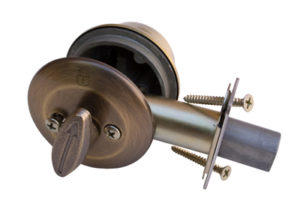Deadbolt should prevent burglars, not prevent you from getting out. Simply put: Don’t block your escape route in the event of an emergency.
 There are many things you can do to boost home security, such as adding an alarm system or getting a guard dog, but unless you have working deadbolt locks and actually use them, your home isn’t secure, locksmiths say.
There are many things you can do to boost home security, such as adding an alarm system or getting a guard dog, but unless you have working deadbolt locks and actually use them, your home isn’t secure, locksmiths say.
Many home intruders use force to gain entry in a majority of home burglaries. Often, deadbolts and locks in general are not functioning properly or they are simply inadequate, so the intruder is able to kick the door in.
A deadbolt is a type of lock with a steel bolt that extends into the door jamb and strike plate of a door frame. The most common type is the single-cylinder deadbolt, operated by a twist knob on the inside of the door and a key on the outside. Some people prefer the double-cylinder deadbolt, which doesn’t have a twist knob and requires a key for operation both inside and outside the home.
Forced Entry
According to the latest FBI statistics, there were 1.9 million burglaries in the United States in 2013, resulting in $4.5 billion in property loss. Out of all burglaries, 59 percent were the result of forced entry. Residential burglaries accounted for 74 percent of all burglaries, and a majority occurred during the daytime.
Quality deadbolts with a hardened steel bolt are suggested. For the deadbolt to function properly, the bolt must extend fully into the hole on the door jamb. The hole should be reinforced with a metal strike plate. If the bolt doesn’t extend all the way into the hole or if a strike plate isn’t used, the lock and door frame can be compromised.
Usually, when someone kicks in a door, it’s not the door that breaks – it’s the door frame. Therefore, you should use 3-inch screws to reinforce the strike plate into the studs of the frame of the house.
Even if you have a deadbolt lock on your door, it won’t make a difference if it’s not used regularly. Typically, many homeowners find it easier to lock the doorknob and often neglect to lock the deadbolt.
Although doorknobs are convenient, it’s deadbolts that make everything more secure.
Single- versus Double-cylinder?
Homeowners should take note that a single-cylinder deadbolt can be breached if an entry door has glass panels, because a burglar can break the glass and reach inside to unlatch the deadbolt. A double-cylinder deadbolt will protect against this, and we recommend homeowners keep a key close by – but out of arm’s reach. However, the double-cylinder deadbolt can be problematic in the event of a house fire because a key is required to unlock the door from the inside.
Another solution may simply be to replace the door itself. Many exterior doors are designed with security in mind, using reinforced glass or small windows far enough away from the lock to prevent a burglar from reaching in.
For additional security, avoid hiding a spare key under the doormat. It’s better to get a secure lockbox for your spare key. It is also recommended new homeowners have their locks changed, because there is no way to know who previously owned keys to your home.
If you need help installing a deadbolt lock in your home, give Pop-A-Lock Jacksonville a call at 904-246-4590.

